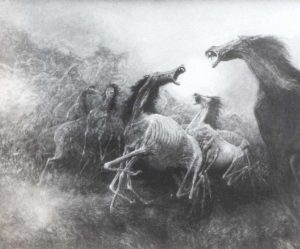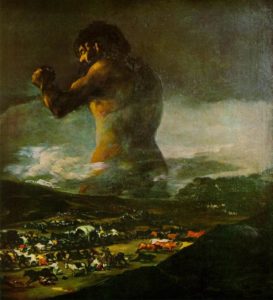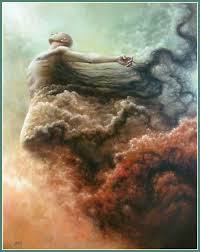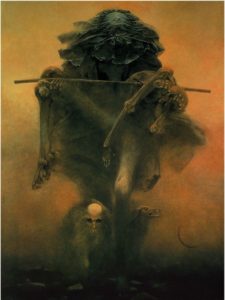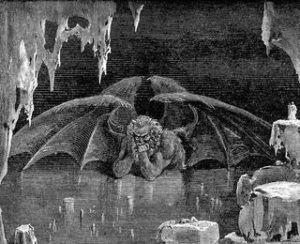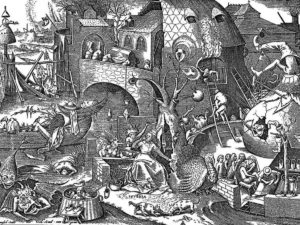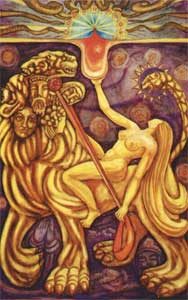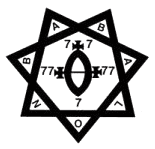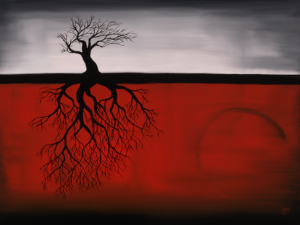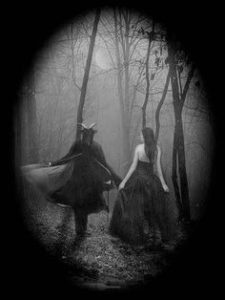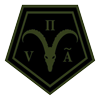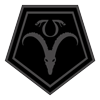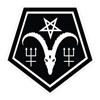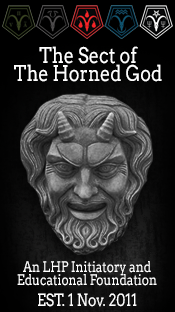Rebellion Vs Religion
By Eric ~ Member of the Sect of the Horned God
I base this essay on the YouTube video by Thomas LeRoy called The Sect Vs Online Satanists as it was moved me because of the message it held. In my mind, rebellion is a way of pushing back against views that you do not agree with, and in most cases, the views of teenagers. A teenager sees the world one way because he or she has not fully experienced everything that life has to offer. A rebellion should have purpose, it should mean something to those who are rebelling, and not have to do with religion.
Religion is a belief system that we are taught or learn as we grow and like some (myself included) the views can change over time. Thomas LeRoy and Mistress Babylon talk about how it shouldn’t matter to anyone what other religions do unless that religion affected us as children. I grew up Catholic and was forced to attend church. I never understood how the church could tell nuns and priests that they were not allowed to have sex, but the abuse of children was a hush hush situation. This is a fine example of who cares, and why rebel against something I cannot control?
To me a Satanist is his or her own god with his or her belief system and someone that respects all religion regardless of how he or she feels about that religion. I used to believe that way that I think today was ridiculous. How could anyone believe in Lucifer as the teacher or the bringer of light? A lot of these views changed for me after reading The Devil’s Apocrypha by John DeVito. Are we simply crazy for believing we are our own gods? Are all religions just mythology made up by man to help us sleep better? I don’t think we will ever have a true answer to these questions.
Like anything in life that we enjoy, we should not allow that thing to control our lives but rather allow it to help guide us only as far as we wish to go. Mistress Babylon talked about indulgence and not allowing this to justify you being an asshole. Yes we all need to calm down and stop pretending that we are somehow better than those who have different views. My path is not rebellion; my path is further knowledge about things I wish to understand.
In conclusion I see the path to enlightenment. I seek my new religion as a way of learning about what I was once told is wrong and taboo. The first time in my life I feel free of societies and families pressure to be part of something that I do not wish to be a part of. I will not pretend to have the answers because I purchased a satanic bible, and I will not pretend I have all the answers. I hope to one day meet others and learn from them as they help guide me to the truth. Religion should not be about hate or being considered and outsider due to sexual orientation, it should be about love and axcepting others for who they are.
The Virtues of Never Turning The Other Cheek
By Steve Sitri ~ Member of the Sect of the Horned God
“You cannot love everyone; it is ridiculous to think you can. If you love everyone and everything you lose your natural powers of selection and wind up being a pretty poor judge of character and quality. If anything is used too freely it loses its true meaning. Therefore, the Satanist believes you should love strongly and completely those who deserve your love, but never turn the other cheek to your enemy” – Anton LaVey
I was taken back to this statement by Anton LaVey during my studies to obtain the knowledge of The Order of Pan. When I was a child I wanted world peace. I wanted everyone to be able to “just get along” and live in harmony. I wanted violence to become a thing of the past.
Fast forward 30 years. Since then I’ve been beaten, robbed, hustled, ridiculed, and told countless times how I am going to burn in Hell for eternity. I’ve been through a marriage where I gave 110% and my ex-partner checked out as soon as we said our vows. I’ve been stabbed in the back repeatedly and left with nowhere to turn when I hit rock bottom.
I realized more and more with each incident that I was cut from a completely different cloth than most of those around me. I’d slowly but surely had become emotionless and detached. I’d realized that I was alone and I had toughened up and become quite callous in the process. It didn’t take me long to realize how ridiculous my original line of thinking was! I’ve since learned to stop giving away my love so freely. I’ve learned that all who smile in my face are not my friend. I’ve also learned to stop turning the other cheek.
Now let’s rewind back to my childhood. I was a bully as a little kid. By third grade I moved past that and had completely given up on violence, wished for peace, buried myself into books, became an honor student, and tried my best to avoid fights. I became a nerd to put it lightly.
There was an incident when I was in middle school where I was at recess and was minding my own business. All of a sudden something hit me really hard from behind and I was face down, clothes full of mud. I stood up and turned around and the guy who did it was standing there laughing.
It was all fun and games for about 10 seconds. I stood up and smashed his left cheek as hard as I possibly could! He immediately lost his sense of balance and the smirk on his face. I felt a supreme sense of hatred surge through me after the first punch. It was a very deep, seething, malicious hatred – the depths of which I had never felt before. I embraced the rush of adrenaline and charged at him full speed. He was still dazed and I gave him the old 1-2 combo until a teacher broke it up. I explained what happened and I was not sent to the office. I felt real power for standing up for myself. I took my Grandfather’s advice from when I was a kid and I applied it firsthand: I struck first, I struck hard, and I made sure that everyone had seen it.
In hindsight that incident was a major turning point in my life. It had the effect of me becoming more outspoken, more confident in myself, and no longer was I going to be taking any shit from anyone. This was when I started to rebel against religion. This incident was my awakening – the beginning of my walk down the Left Hand Path.
So remember to always use your love sparingly, embrace the hatred when it finds you, and take matters into your own hands as needed so justice can prevail. It will save you a lot of pain and heartache. I can promise that you will be a much better person for it in the long run. Hail Satan!
The Free Will of Fate
What is free will anymore?
The Adversary: Living a Life of Opposites
Austin ~ Member of The Sect of the Horned God
In no reality will Satanists live in a world of peace. It is a lie, a grim fantasy bereft of rage and legitimate accomplishment. Man is an animal of conflict, of war. The Satanist exists in a reality that is comprised of chaos and recognition of the not-so-pretty realities of life. This recognition is an undeniably positive one though, as the Satanist possesses the unique ability to grasp the destructive nature of humanity and claim it as his ally. As Satanists, we are aware that up is down, left is right, war is peace, and freedom is slavery. When the Satanist lifts himself from the ill-begotten, manufactured high-horse he has been told he must ride to Heaven, he recognizes that his reality is unique to him, and that, because of such a gift, he can expect nothing but war.
When confronted on why the Bible-thumper lives a life of submission and slavery, he would often respond with, “Well, the Bible says I must have faith in my good pal Jesus to get into Heaven.” This is easily one of the clearest picture the Satanist can paint when explaining why “up is down”. To him, Heaven is the place of torment, the one and only Hell. Spiritual submission is an outright revolting concept, as the biggest and most severe crimes one could commit against themselves would be to become a slave to his own imagination. Even if the Christ-Dildoer were to prevail in his proselytization, the illusion of eternal peace would so effortlessly crumble, as now he must live a life of alienation. Alienation from his instincts, alienation from his desires, and worst of all, alienation from truth.
An incarnation of the flip-flopped reality walkers of the Left Hand Path exist in, is found in the George Orwell novel “1984”. Although, the adversarial concepts like “left is right” were meant to outline Big Brother and his malevolence, the Satanist takes hold of this idea and proclaims it his ally. Intellectually and literally speaking, left truly is right, as the self is put through a process of deification. This inversion can be interpreted as an inversion of morality and its objectivity. “Responsibility for the responsible” is a commandment perpetuated by Doctor Anton LaVey in the Satanic Bible. Love and care is not to be wasted on those who are judged unworthy, a position completely opposite to the one found in the Holy Bible which praises perpetual abuse of love. From a moral standpoint, “left is right” could not possibly be a more apt descriptor. The Satanist obeys his instincts above his emotion, and shuns the “love your enemies” idea as a dishonest, unnatural pipe dream.
The Seventh Satanic Statement goes as follows, “Satan represents man as just another animal, sometimes better, more often worse than those that walk on all-fours, who, because of his “divine spiritual and intellectual development,” has become the most vicious animal of all!” (Lavey). Moreover, as such, man is privy to endless conflict, whether it be over territory, food, or potential mates. Man is vicious, and Satanism emphasizes the recognition of this aspect of our instincts, and embraces it. War is intertwined in the very blood that so many pious, righteous people of the faith pretend they would never, under any circumstances, shed (although history says otherwise). The aforementioned point that there is no creation without destruction outlines that conflict is an inevitability of life. This is not of course a bad thing however. Mental and creative conflict can be the greatest of influences in producing magnificent works of art, poetry, literature, etc. Through the conflict of all kinds that as humans, not just as Satanists, we will face, we are presented with a unique opportunity to turn our troubles into triumph.
It is fair to say that as people, we are not equal. Science, for example, is continuously discovering physical and psychological differences between the sexes for example. The Satanist recognizes the innate characteristics that set him apart from the rest of the world, and can clearly see himself as an animal living in a cruel, unforgiving world. As animals, humans too are imperfect, selfish, and flawed. The concept of freedom is unattainable, as man is again, selfish and will cause chaos in order to get what he needs. Naturally, governments have tried and failed to establish a limited form of freedom and have repeatedly failed. The Satanist sees man as incapable of handling the responsibilities that freedom entails. The manufactured form of freedom so-called “Democratic” societies embrace, has been built upon Holy foundations, and, as such, people have been taught to deny themselves and their instincts. Christian slavery has seeped into every facet of society, and has embraced Capitalistic money-mongering in an attempt to control man. To the Satanist, freedom is only found when he looks inward.
The word Satan simply means, “The Adversary”. To be a Satanist, you live a life centered around morals and values that are an inversion of those said to be Holy. Satanism recognizes that living any other way would be a farce, and welcomes the struggles of living an honest, fleshly life. To us, Heaven is Hell, wrong is right, destruction is necessary for creation, and inequality is equality. Conflict is as essential to the Satanist as his heart, as without it, his heart would have no reason to continue beating.
Satan as a Symbol
By Vladislav ~ Member of The Sect of the Horned God
Although the phenomenon of atheistic religions (there are many as Satanism is not unique in this regard) should be known to the average educated person, many people are confused when they hear of someone calling themselves a Satanist without believing in the literal existence of Satan.
It is often claimed that the LHP Atheist is emotionally addicted to “Satanic imagery” or “It’s just Dawkins in gothic clothes” and even “They would be more honest by identifying themselves as just Atheists.”
While there is an absence of belief in Satan (or any gods) as a literal being in modern Satanism, to reduce it to “Just Atheism” indicates intellectual laziness or very limited knowledge of what the core of Atheism is actually about. Dawkins, Marx, Nietzsche, Rand, Comte, Hume, Hill, Sartre, Russell, Schopenhauer, Spencer, Democritus, among many, did not believe in existence of deities, nor did they have not much in common. Each of them created a unique system of thought where much more than just the absence of god could be learned from (In fact, there is more diversity in Atheistic philosophies than in Theistic). LaVeyan Satanism as an Epicurean philosophy / Social Darwinism / Objectivism / Secular Humanism with Satanic trappings would be more accurate than trying to dissolve it under a broad “Atheism” label. But this is still not correct since LaVeyan Satanism differs from each of the above mentioned.
What Theists do not realize is that their own claim and use of Satanic (or any other, e.g. Egyptian, Pagan etc.) imagery is nothing more than self-deceit only for sake of glamour, and would apply, as well, (or even more) to themselves, if accepted with all its consequences. First, it takes much more substantial self-deceit to actually believe in literal existence of deities. Second, many Theists themselves use imagery and symbolism on top of their superstitions, although they are not always aware of it.
Let’s assume that the Theist in question does not actually believe in a deity in the form of a being with horns and tail, or a donkey resembling Set, and that his concept of this deity is little bit more abstract and ambiguous. It can be, for example, some “(anti)cosmic force” which controls evolution or wants (note that subtle anthropomorphism) to destroy the cosmic order. It could also be the “principle of individual consciousness,” without which/whom individual consciousnesses would not exist. In this case, the horns, tail (or the donkey head), the name “Satan” (or “Set”) and any associated imagery and names are largely of symbolical nature, since this Theist would admit that his deity – his lame metaphysical concept, does not actually have horns, and the name “Satan” is not inherent to it. So if this Theist asks: “Why are you calling yourself Satanist if your worldview is just Atheism wrapped in satanic imagery? It would be more honest to label yourself an Atheist”, he should then be aware that he could be asked similar question: “Why are you calling yourself a Satanist if your worldview is just superstition wrapped in satanic imagery? It would be more honest to get rid of the delusional mumbo-jumbo and fancy imagery you believe in so it will be exposed for what it is” Choosing examples, I stayed in the realm of a Satanist, but this applies to any other theistic religion.
Thus, symbols and metaphors are used even in theism, whether its proponents are aware of it or not (otherwise, they had to admit they are on that “comic book level of their religion”). Sketchily understanding of this notion has led some people to conclusion that the two approaches differ only seemingly. This is not true. The difference is in what the symbol is used for and what is behind it. Using a rational approach, it represents natural phenomena that is not in conflict with scientific the understanding of the world, nor can they be considered superstitions which fills gaps in current knowledge. For example, indulgence, life, death, sexuality, freedom, justice, some aspect of the self etc, and are in no way supernatural. If a rational individual regards this phenomena as sacred, he may feel the need for their symbolic representation in the form of mythological deities in order to engage the same layers of mind which respond to dream and art. But he never crosses the line between knowingly using metaphors and confused childlike magical thinking ascribing causality, will, mind and purpose where there is none.
Belief in literal existence of deities does not make the use of mythology and satanic imagery more valid, as some often argue. It is quite the contrary. In the case of theists, use of trappings and symbolism (for which he reproaches the rationally inclined satanist) only conceals ambiguousness and uselessness of that very supernatural concept he believes in.
The Seven Deadly Sins
By Logan ~ Member of The Sect of the Horned God
According to Christianity the Seven Deadly Sins are
1) Lust
2) Gluttony
3) Greed
4) Sloth
5) Wrath
6) Envy
7) Pride
“Satanists are encouraged to indulge in the seven deadly sins as they need hurt no one; they were only invented by the Christian Church to insure guilt on the part of it followers.” -Anton LaVey, The Satanic Bible, pg. 85
But herein lays the issue:
Is it not as detrimental to indulge, as it is to abstain? Is the “over-correction” of a malady its salvation? I would venture to say it is not. The “Yin and Yan” of life ebbs and flows, like the cylindrical pendulum of life. Is abstinence not the indulgence of inaction?
A man dying of thirst need not sink to the bottom of the ocean to quench it nor does he need to jump directly into a blazing fire to warm himself on a freezing winter night. Too much of anything is just too much. Now the rebellions and heretical nature of LaVey’s teachings would have us naturally gravitate to the opposite of the dogmatic Right-Hand Path. While there is justification clearly outlined in “The Satanic Bible,” I would also like to point out that this book was written during a time of great social reform in the United States.
Anton LaVey was a pioneer of the Left-Hand Path regarding the Western thought. Both he and his teachings have stood the test of time and faced the scrutiny of over fifty years of interest, fear and speculation. But I believe that as all things naturally evolve, so has our understanding of the Left-Hand Path. And of Satanism specifically. I believe both time and the devout practicioner of Satanism have both equally realized the folly of this philisophical polarity. I need not spray my arm with dry ice to treat a burn. Neither will I practice either indulgence or abstinence of anything. And this includes the infamous Seven Deadly Sins.
Satanism promotes logic and rational thought. It should not take the aspirant long to realize the potential dangers of mere contradiction. This is responding emotionally to an issue that can be circumnavigated logically. To merely oppose an archaic or pseudo-sanctimonious dogma, is to simply rebel for rebellions sake. Such a knee-jerk reaction can be exploited by the nefarious observer. I cannot think of any self-respecting Satanist that will not take this into account.
Finally, the very word “Sin” is a misnomer in Satanic terms. If we refute the slavery of dogma; and defy the oppression of the Right-Hand Path, how then can we use their terms without appearing subservient to them or even in rebellion? The time has come for The Left-Hand Path to find the equilibrium of logic and belief within itself. We must break away from these simplistic ideas of “Sin” and “Hell.” These terms were coined and used by those who would enslave the world by its out-dated and simple fairy-tales.
The Whore of Babylon
“And there came one of the seven angels which had the seven vials, and talked with me, saying unto me, Come hither; I will shew unto thee the judgment of the great whore that sitteth upon many waters: With whom the kings of the earth have committed fornication, and the inhabitants of the earth have been made drunk with the wine of her fornication.” –Revelation 17
The Whore of Babylon is a figure of abomination originally mentioned in the Book of Revelation. The writer of Revelation, John of Patmos, used Babylon as a symbol of the enemies of God and His people. When he wrote it around 100 AD, John meant Babylon to represent the great power of the day, the Roman Empire, which was persecuting Christians. The people of that period understood metaphor and would have got the meaning of his message. But, of course, modern Christians interrupt it differently. They see either the Roman Catholic Church, or any other “false church”, (or even the city of Jerusalem) as being the “Whore”. Thus, they are breathing life into the Book of Revelation, making it pertinent to today’s world and their apocalyptic vision.
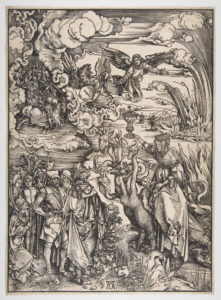
In Thelema, Aleister Crowley saw “Babalon” (as he spelled it) in the goddess form. As Crowley wrote in his Book of Thoth, “she rides astride the Beast; in her left hand she holds the reins, representing the passion which unites them. In her right she holds aloft the cup, the Holy Grail aflame with love and death. In this cup are mingled the elements of the sacrament of the Aeon”. In this abstract interpretation she represents the female sexual impulse and the liberated woman. She is also the consort of Chaos, the “Father of Life” and the male form of the Creative Principle. This brings in the male/female dynamic found in the world’s great mythologies, such as the Horned God and the Goddess, Shiva and Shakti, and, as been postulated here in The Sect, Satan and the Virgin Mary.
In the Gnostic Creed, the Whore is mentioned as follows:
I believe in one secret and ineffable LORD; and in one Star in the Company of Stars of whose fire we are created, and to which we shall return; and in one Father of Life, Mystery of Mystery, in His name CHAOS, the sole viceregent of the Sun upon the Earth; and in one Air the nourisher of all that breathes.
And I believe in one Earth, the Mother of us all, and in one Womb wherein all men are begotten,and wherein they shall rest, Mystery of Mystery, in Her name BABALON.
And I believe in the Serpent and the Lion, Mystery of Mystery, in His name BAPHOMET.
And I believe in one Gnostic and Catholic Church of Light, Life, Love and Liberty, the Word of whose Law is THELEMA.
And I believe in the communion of Saints.
And, forasmuch as meat and drink are transmuted in us daily into spiritual substance, I believe in the Miracle of the Mass.
And I confess one Baptism of Wisdom, whereby we accomplish the Miracle of Incarnation.
And I confess my life one, individual and eternal that was, and is, and is to come.
AUMN. AUMN. AUMN.
In the creed she is also identified with Mother Earth, in her most fertile sense. At the same time, Crowley believed that Babalon had an earthly aspect in the form of a spiritual office, which could be filled by actual women—usually as a counterpart to himself, “Mega Therion” (The Great Beast)—whose duty was then to help manifest the energies of the current Aeon of Horus.
Babalon is identified with Binah on the Tree of Life, the sphere that represents the Great Sea and the mother-goddesses Isis, Bhavani, and Muat. Moreover, she represents all physical mothers. As Thelemic authors Sabazius and Helena wrote:
BABALON, as the Great Mother, represents MATTER, a word which is derived from the Latin word for Mother. She is the physical mother of each of us, the one who provided us with material flesh to clothe our naked spirits; She is the Archetypal Mother, the Great Yoni, the Womb of all that lives through the flowing of Blood; She is the Great Sea, the Divine Blood itself which cloaks the World and which courses through our veins; and She is Mother Earth, the Womb of All Life that we know.
The Darkness of Solitude
By Jason Smith
Sect of the Horned God Member
Something that literally just came to me: The lights have dimmed, and the Darkness of Solitude embraces my Mind in its velvet touch. Free from the noise of Light, I see the Pattern in its completeness, but I cannot distinguish its Ultimate Purpose. Nor, indeed, do I care to, for to see the Outcome is to finish the Puzzle. My Time is short, but my List of Knowledge is seemingly endless, and the Path will continue on into the Darkness, long after my Spark is extinguished. Assailed on all sides by the encroaches of the Light, I find solace in the silence of this hidden way. May the poisoned thorns of the ever-accursed never penetrate this membrane of quiet contemplation!
Between Bliss and Torment
By Brian
In the Nine Satanic Statements, Anton LaVey outlines the emphasis that Satanism places on carnality. “Satan represents indulgence instead of abstinence,” “Satan represents kindness to those who deserve it instead of love wasted on ingrates,” “Satan represents responsibility to the responsible instead of concern for psychic vampires,” etc. The obvious interpretation is that Satanists revel in pleasures of the flesh instead of imposing upon ourselves harmful dogmas that needlessly suppress our natural desires. However, I think that there is a deeper truth to be found here than the obvious one. It is not just that we enjoy the “sins” other religions shun; it is that we allow ourselves to experience the full range of emotion of which we are capable.
In the chapter “Love and Hate” in The Satanic Bible, LaVey discusses both the absurdity and the hypocrisy of those who promote a “love everyone” mentality. He explains how attempting to love everyone cheapens the emotion, washes it out, so that the people who truly deserve our love do not receive as much as they should because we are too exhausted from the effort required to force ourselves to “love our enemies.” There is a saying, often used in response to the sniveling whine of one who believes that he or she is not receiving nearly enough attention: “Yes, you are an unique and beautiful snowflake, just like everyone else.” In other words, yes, everyone deserves some measure of respect, but some deserve more than others, and there is no shame in admitting this fact. Furthermore, there is no shame in admitting that some deserve our contempt; however, how we channel that contempt is very important. We ought to direct it constructively, lest we waste our time or – even worse – it comes back to harm us. How often do we see the phrase “Don’t feed the trolls” when reading a particularly stupid post and its associated comments in forums and on social media? Sure, you can waste your time hurling insults or refuting the mindless vitriol of an ignorant person, inevitably making little difference as you give them the attention they so desperately want, or you can use that contempt constructively by releasing that anger in the ritual chamber or by writing something thoughtful elsewhere, where it has the opportunity to make a difference.
In “Indulgence… Not Compulsion,” LaVey describes the chief difference between indulging in our desires and being compelled to do something, even if it is enjoyable: choice. It is lack of choice that produces a compulsion, and a compulsion perpetuates the lack of choice when a person is powerless to resist it. Addictions of all kinds, whether they are physical or psychosomatic, are perfect examples of compulsion. When we are free to explore our desires in a safe way so that they need harm no one, we are set free from the artificial chains that inevitably produce compulsions. And it is not just pleasure that some people fear, but also pain. Many people flee from the “negative” emotions like pain and sorrow that produce suffering, never allowing themselves to feel these like they do the “positive” emotions. This is folly. One look at the S&M community will easily dismiss the notion that pain is always bad, and it is widely understood that delaying gratification can enhance pleasure later. Sorrow can also induce a deeper appreciation for the things we have now. Running from these emotions and seeking only to feel pleasure is itself a compulsion we ought to avoid.
The Buddhist will tell you that it is attachment to things that leads to suffering. While true, this axiom ignores the simple fact that suffering can lead to greater pleasure. “I did not know what I had until I lost it,” says the one who has learned a valuable lesson: indulge in what you have! Permitting ourselves both pleasure and suffering, love and hate, allows us to live as we are, free of compulsions and liberated from the chains of absurd dogma. The deeper truth that I think LaVey was hinting at was not just that we could be truly liberated by enjoying all of our desires, but that we can become masters of the desires themselves. While the dogmatist runs from desire, runs from pain, runs from everything in a race to oblivion, the Satanist understands and enjoys these things responsibly, and in so doing becomes the very thing the dogmatist fears: a god.
Satanism and Self-Love
By Rachel
Sect of the Horned God Member
Growing up in a Protestant home, with a grandmother who was very devout in her beliefs (I will never forget her warning me about the “Dogans”), I will always remember the guilt that followed me around as a child. There was guilt attached to everything. Don’t do this because you’ll go to Hell, don’t do that because it’s a sin. I wasn’t allowed to own a Marilyn Manson CD until I was 18, because my mother watched a segment on the news that showed him ripping up a bible onstage. (Thanks to Napster and the wonders of the internet, that didn’t deter me from getting my black-polished claws on a copy of “Smells Like Children.”)
Guilt placed on a child is very damaging, especially on those who already have a predisposition to be anxious and depressed, like I was. I wasn’t diagnosed until I was 16-going-on-17, but the pressure to conform and the guilt of being unable to leaves a lasting impression. I like to akin it to Dexter’s Dark Passenger. That little mocking, condescending, nagging voice that cuts you and reinforces your feeling of insignificancy. “God doesn’t love little girls who don’t listen to their mother.” “Suicidal thoughts mean you’re not right with Christ. Pray on it.”
Eventually, some part shuts down, shuts off. Life greyed over, I fell more into my listlessness and my apathy, and blamed myself. That indifference lent itself to alcohol and substance abuse and cutting. I tried to talk to a couple of friends about this, and in return I received an indignant speech about how if I killed myself, I’d go to Hell. Adults around me were just as indignant and unhelpful.
Feeling separate from my friends, I spent many long nights on the internet. I don’t remember how exactly I stumbled upon Anton LaVey. This was before the days of Google, so who’s to say? I ended up on the Church of Satan website, and I devoured the entire thing from entrance page to fine print.
I had never heard or encountered anything quite like it. Getting my hands on the Satanic Bible was a bit tricky… living in the Bible Belt of BC, I couldn’t just walk into the library or the local bookstore and ask for it. One of my best friends at the time lived in Mississauga, and she sent me a copy she had found in a shop.
I always call the reading of The Satanic Bible my “first act of self-love.” Through reading The Satanic Bible, I came to understand that the reason I was so miserable, the reason that I was struggling was because I was in denial of pretty much everything – my nature, my happiness, exercising my true potential and becoming the best version of myself. I allowed the guilt imposed on me to control me, and the moment I realized that and accepted it, I was free of it.
The Satanic philosophy allowed me to take control of my life, and empowered me to open up my eyes and live fully. Applying this philosophy to my life has given me success and happiness, and I feel vital and alive. I am not a LaVeyan, but I like to think that LaVey opened the door and booted my ass through it. Did Satanism save my life? Absolutely not. It gave me the tools and the knowledge to save myself.
